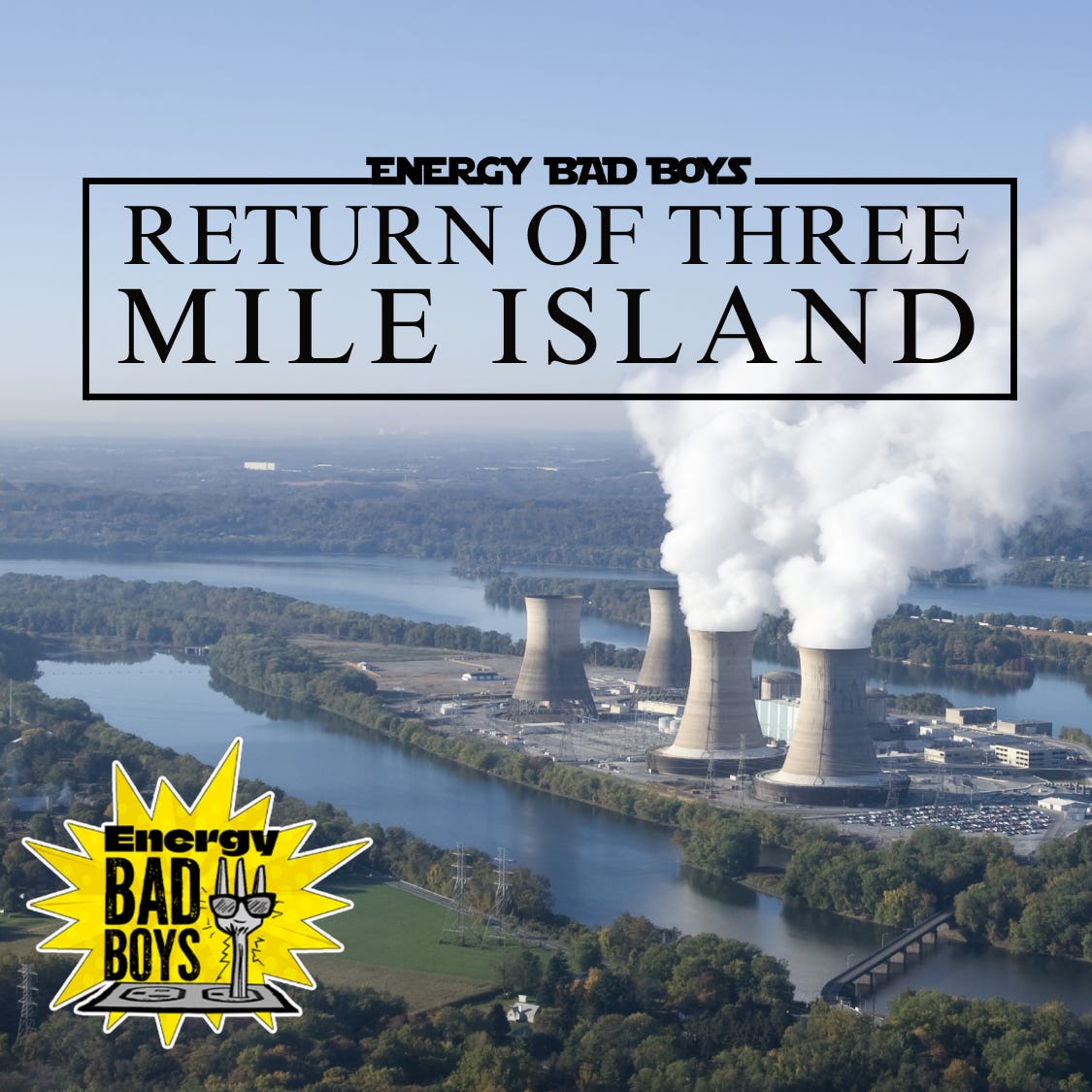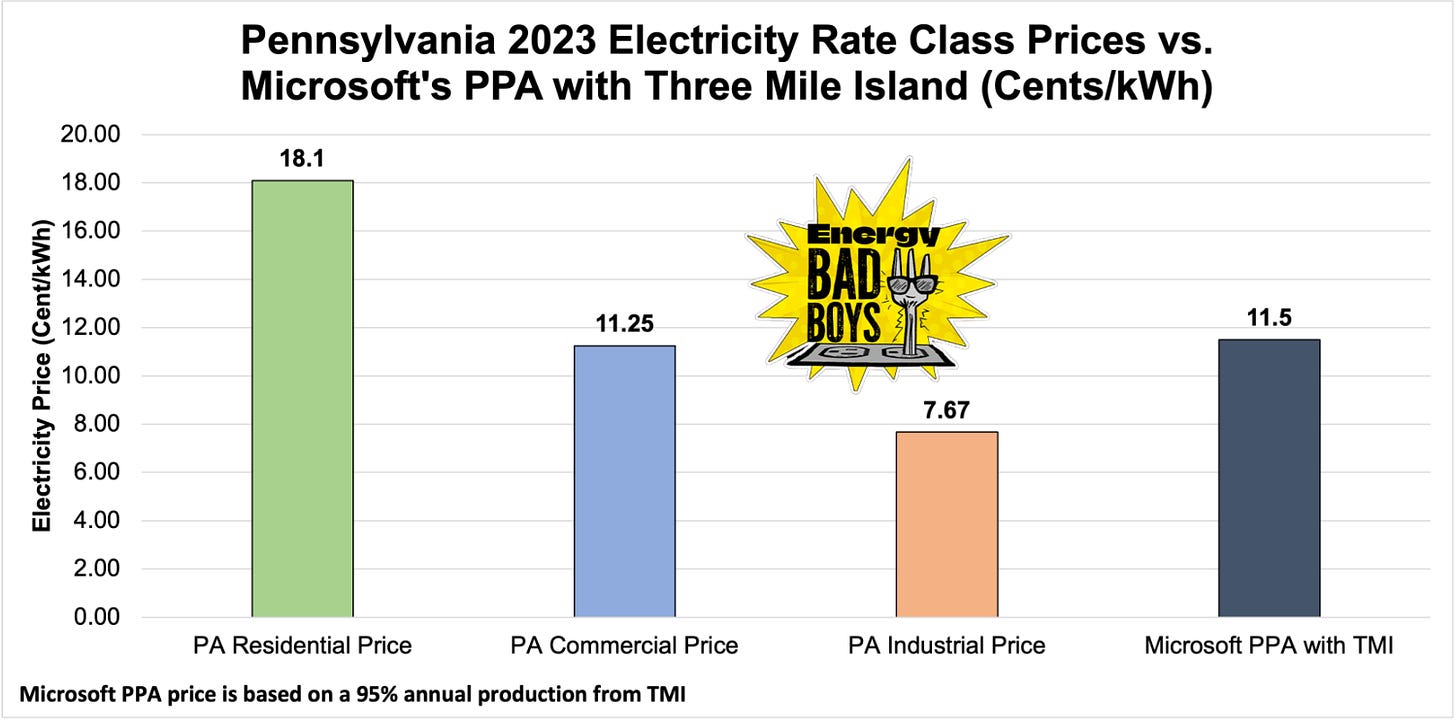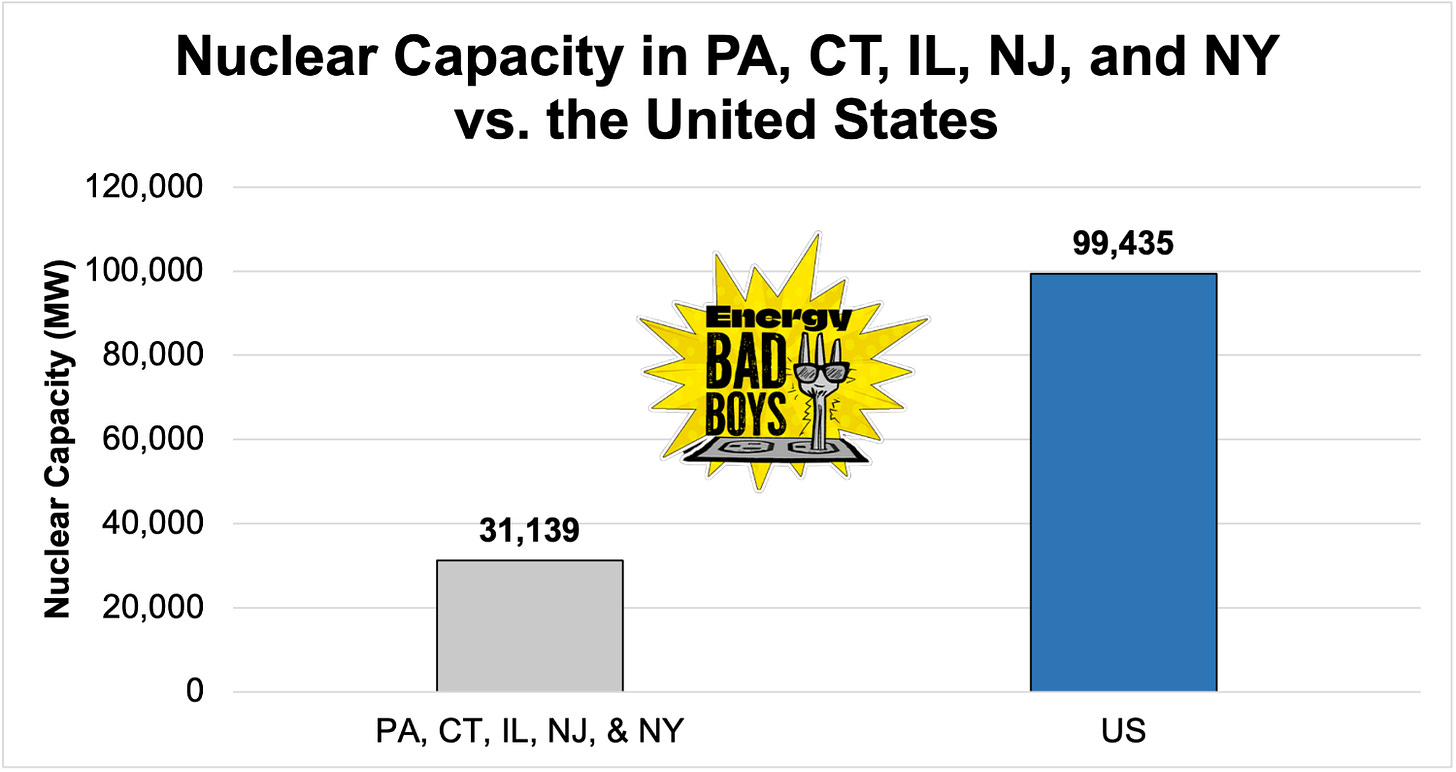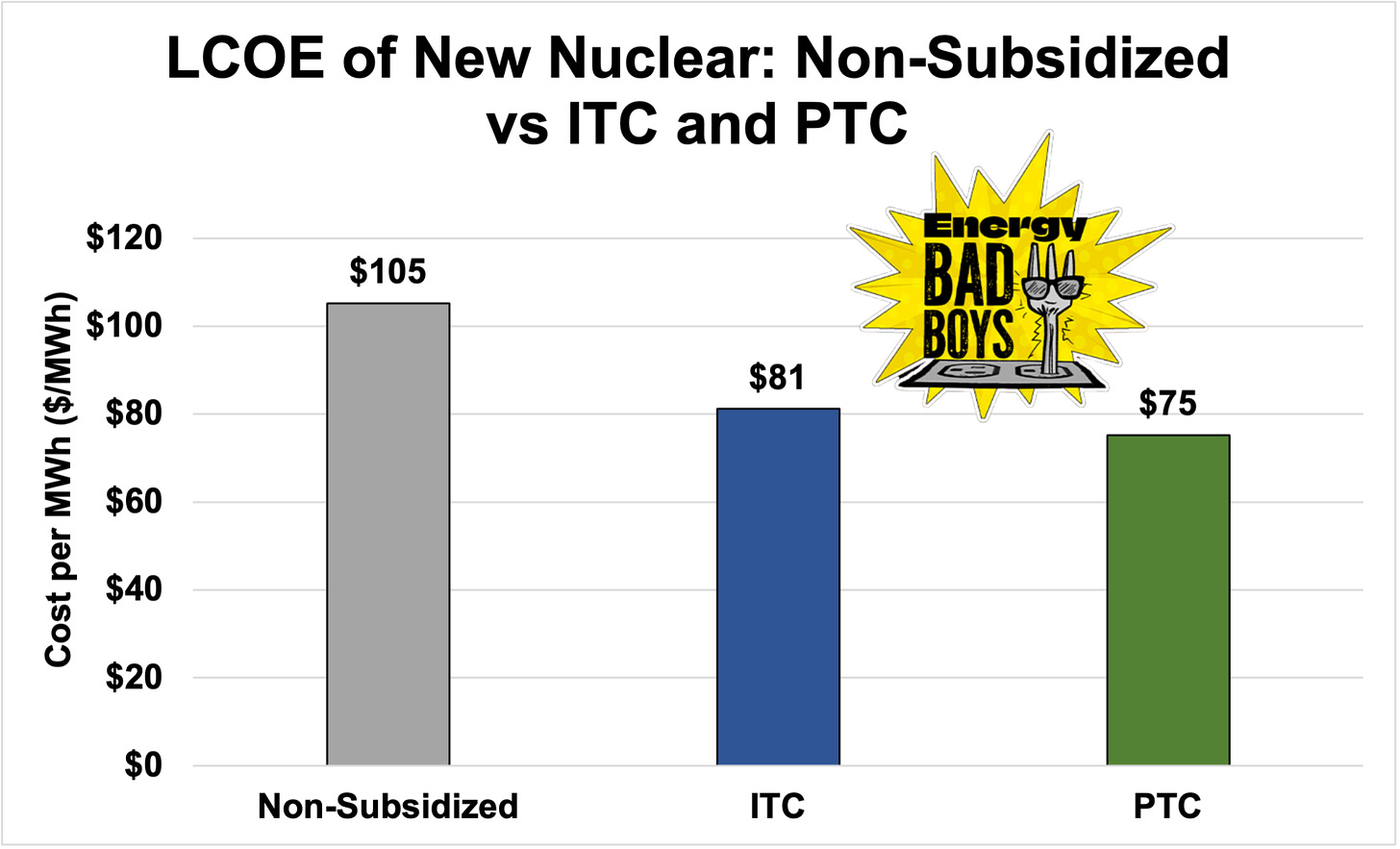The Return of Three Mile Island
Why it's a win for nuclear and reliable power, but a loss for energy markets
Before we get into Three Mile Island’s new life, we have some exciting news. Isaac is proud to announce the newest Energy Bad Boy: Meet his new son Milo!
This is exciting news. However, Isaac will be on paternity leave for the next few months, and we will be operating at half of our Bad Boy capacity. So during this time, we are committing to publishing two articles per month instead of our normal one per week. We may end up posting more than this, but these will be bonus articles. We appreciate your understanding!
Introduction
In a first-of-its-kind move, the Three Mile Island (TMI) Unit 1 nuclear facility in Pennsylvania – now being renamed the Crane Clean Energy Center – is coming back online after being shut down in 2019 and will sell 100 percent of its electricity to Microsoft and its anticipated data centers.
This is a win for nuclear energy and for ensuring reliable power for the country’s growing energy demands. The combination of data center growth and the electrification of transportation and home heating will result in a dramatic increase in electricity demand, and this will require us to build - or restart - more reliable power plants in the future like TMI.
However, there are a few underlying issues that should give us pause.
For starters, while this is great for Microsoft, it highlights a major issue of current electricity markets, as they seem unable to facilitate the desire for reliable power in the form of nuclear energy. Large companies will be able to secure what they need through off-market deals like this, and we applaud their effort, but smaller customers won’t be able to do the same. The rest of us who can’t turn to off-market deals are relying on companies currently facing massive coal and nuclear retirements in the coming years with largely wind and solar being built to replace it. And as we’ve shown before, wind and solar won’t be sufficient to keep the lights on.
Second, there’s a reason why this unit can come back online after 5 years of being dormant, and much of it has to do with the financial incentives included in the Inflation Reduction Act (IRA) that provides substantial subsidies to nuclear generators.
Restarting a nuclear power plant with subsidies is far better than continuing to solely subsidize wind and solar and, as a result, price out of the market facilities like TMI. However, the ultimate goal should be to level the playing field by eliminating subsidies for all energy sources - not by passing more subsidies to offset the destructive nature of other subsidies, which will lead to an incredibly inefficient and expensive system.
Here’s everything you need to know about the deal.
The Deal Between Microsoft and Constellation
Microsoft and Constellation Energy have agreed to a 20-year power purchase agreement (PPA) to bring the plant back to life.
The Crane Center unit will require a $1.6 billion investment to get it ready for operation, and Microsoft will purchase 100 percent of the power for around $800 million per year. This would result in a cost per MWh of over $100 – which is a bit more expensive than current industrial electricity rates in Pennsylvania, but this may change once the facility comes online in 2028 (anticipated).
Constellation CEO, Joe Dominguez, said “Powering industries critical to our nation’s global economic and technological competitiveness, including data centers, requires an abundance of energy that is carbon-free and reliable every hour of every day, and nuclear plants are the only energy sources that can consistently deliver on that promise.”
We disagree that carbon-free energy is needed to power our nation’s industries, as fossil fuels have been doing it for a century now and could continue for many more. However, Dominguez is correct that businesses need reliable energy sources, and deals such as this, along with the one Amazon worked out with Talen Energy’s nuclear facility in Susquehanna, reflect that businesses are starting to understand that wind and solar won’t be enough to power their operations fully.
The TMI unit still has some hurdles, including inspections from the Nuclear Regulatory Commission (NRC) and obtaining the necessary local and state permits. Once in operation, a study commissioned by the Pennsylvania State Building and Construction Trade Council estimated the project will create 3,400 jobs – 600 of them being permanent at the plant – and generate $3.6 billion in state and federal tax revenues.
Pennsylvania governor Josh Shapiro showed his support for the project, saying the plant “will safely utilize existing infrastructure to sustain and expand nuclear power in the commonwealth while creating thousands of energy jobs and strengthening Pennsylvania’s legacy as a national energy leader.”
Dominquez agreed, noting, “Before it was prematurely shuttered due to poor economics, this plant was among the safest and most reliable nuclear plants on the grid, and we look forward to bringing it back with a new name and a renewed mission to serve as an economic engine for Pennsylvania.”
But this begs the question: why did TMI shut down, to begin with, and what changed to make it viable once again?
Why Three Mile Island Closed in 2019
Three Mile Island closed down in 2019 due to “poor economics” after Pennsylvania lawmakers failed to pass nuclear subsidies to keep the plant up and running. This is unlike other nearby states, which have chosen to provide nuclear subsidies to keep nuclear plants in operation, including New York, New Jersey, Connecticut, and Illinois. Including Pennsylvania, these states collectively house over 30 percent of the nation’s nuclear capacity.
According to PJM’s Independent Market Monitor, the TMI unit was one of three nuclear facilities in PJM facing revenue shortfalls out of 18 nuclear plants in operation at the time. According to Patrick White, research director of Nuclear Innovation Alliance, despite the plant operating at a high efficiency, it was driven out by low natural gas fuel prices and heavily subsidized wind and solar.
At the time, Exelon argued that providing nuclear subsidies would level the playing field and appropriately value its nuclear facility's 24/7 emission-less power production.
Lawmakers, however, weren’t unified on whether the subsidies would be enough to keep TMI open. Several bills were introduced to provide financial assistance to nuclear power facilities in the state, but they failed to move forward because of bipartisan opposition. Committee Chairman of the PA House Consumer Affairs Committee, Brad Roae (R), said, “Even if we did do this, it doesn’t seem like TMI is economically viable,” asserting that “it would close” either way.
This brings us to why Three Mile Island is now suddenly able to return.
Why TMI is Coming Back Now – What Changed?
On August 16, 2022, President Joe Biden signed the Inflation Reduction Act (IRA) into law, providing lucrative production and investment tax credits for existing and new nuclear facilities.
Depending on which incentive nuclear operators choose - the production or investment tax credits - a 1000 MW nuclear facility, for example, could see anywhere from $2.5 to $3 billion in subsidies based on cost estimates from the Energy Information Administration (EIA), lowering their cost per MWh by up to $30 (not including other incentives to increase the subsidy amount).
It’s no wonder, then, that just a few months after the IRA was signed into law, Constellation started discussing ways to bring TMI back online, according to CEO Joe Dominguez. “We started thinking 20 months ago that the right thing was to figure out a way to restart the machine,” Dominguez said during an interview on Bloomberg Television on September 23, 2024.
Brett Rampal, a nuclear analyst and senior director at Veriten, explained that these projects are dependent on tax credits or loans from the federal government. As noted in Heat Map:
“Nobody would be moving forward with these projects,” explained Rampal, without tax credits or “extremely favorable loan support from the Loans Program Office.”
And while Constellation spokesman Paul Adams said that a DOE loan wouldn’t be needed, unlike the $1.5 billion loan approved to restart Michigan’s Palisades nuclear plant, TMI will be eligible for production tax credits in the IRA, which Adams noted “any nuclear plant is eligible for.”
These tax credits are a huge improvement from what was available in 2019, as noted by the senior vice president of federal affairs at Constellation, David Brown, who called the benefits for nuclear power in the IRA “transformational.” He went onto explain how the IRA has allowed the company to begin hiring again - around 3,000 new workers - and renew all 23 of its licensed reactors.
Now, the IRA has also allowed Constellation to bring TMI back to life, which would make it only the second nuclear plant to ever restart after having been shut down.
Conclusion
It’s great to see that nuclear power is getting back in the mix once again. Deals like the one between Microsoft and Constellation reflect the need for reliable, always-available energy to power our businesses.
However, it should be known that the problems facing our grid haven’t disappeared. The distortions in the market that forced TMI offline are still there. The unit is only able to come back thanks to taxpayer support - support that is a part of the same IRA foundation currently propping up the wind and solar industry and wreaking havoc on America’s electricity grids.
Leveling the playing field so that reliable, baseload generators can compete is a worthy goal, and restarting an 835 MW nuclear facility through subsidization is far better than building its firm equivalent of heavily subsidized wind and solar. However, the ultimate goal should be to level the playing field by eliminating all subsidies once and for all, and that means the IRA, too.
We also need to find a way for all consumers - not just large companies - to ensure that they have access to reliable power in the future.
Like this piece if you support reliable energy
Share, subscribe, and comment below to share your thoughts on TMI restarting
Tally Of US Wind & Solar Rejections Hits 735 by
on the backlash in rural America against wind and solar projects. explaining the negatives of electricity deregulation and how environmental advocates have made things worse.










Nuclear power has the highest figure of merit of any electric generation means. It is emission free. While nuclear power is the most reliable, with capacity factors (or percentage of full-power output) over time,) of 90%, nuclear power does not receive economic awards for this reliability. I believe that political pressure from competing energy sources is the root cause. Furthermore, the economic benefits nuclear receives for providing the greatest amount of synchronous grid inertia (SGI) which stabilizes the grid are very low to nonexistent. See the March 4, 2024 article and comments "Why is Synchronous Grid Inertia Important?" https://greennuke.substack.com/p/why-is-grid-inertia-important to learn more.
Thank you EBBs and congratulations Isaac!
Is life without government interference in our lives possible, or have governments taken us so far past this point that even asking the question is futile?